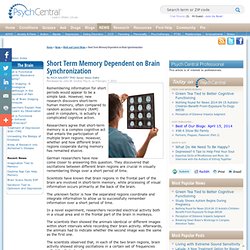

Slices of brain tissue can store patterns of activity for short periods of time: scientists. By Mo Costandi, The GuardianSunday, September 16, 2012 5:44 EDT It sounds like the plot of a science fiction film, or like something from a transhumanist fantasy: researchers from Case Western Reserve University in Cleveland, Ohio, report that they can induce memory-like patterns of activity in slices of brain tissue, and that the slices can store these activity patterns for short periods of time.

The brain can encode information about the outside world and retrieve it later on, and the mechanisms underlying this ability are of great interest to neuroscientists. The general consensus among researchers is that memories are formed by the strengthening of connections within networks of nerve cells, and recalled by reactivation of the electrical signals generated by these networks. The new work, published in the journal Nature Neuroscience, contributes to our understanding of these processes.
The researchers found that each type of input produced a unique output. Reference: Hyde, R. Sleeping brain behaves as if it’s remembering something. UCLA researchers have for the first time measured the activity of a brain region known to be involved in learning, memory and Alzheimer’s disease during sleep.

They discovered that this part of the brain behaves as if it’s remembering something, even under anesthesia, a finding that counters conventional theories about memory consolidation during sleep. The research team simultaneously measured the activity of single neurons from multiple parts of the brain involved in memory formation. The technique allowed them to determine which brain region was activating other areas of the brain and how that activation was spreading, said study senior author Mayank R. Mehta, a professor of neurophysics in UCLA’s departments of neurology, neurobiology, physics and astronomy. “The big surprise here is that this kind of persistent activity is happening during sleep, pretty much all the time.” Brain Blocks Information to Form Memories. Real-time Discovery Engine - YourVersion: Discover Your Version of the Web™ Chance derails brain’s short-term memory. U. PITTSBURGH (US) — Mathematicians are using computational models to better understand how the structure of neural variability relates to short-term memory and decision-making.
In a paper published online April 2 in Proceedings of the National Academy of Sciences (PNAS), the University of Pittsburgh team examines how fluctuations in brain activity can impact the dynamics of cognitive tasks. Previous recordings of neural activity during simple cognitive tasks show a tremendous amount of trial-to-trial variability. For example, when a person was instructed to hold the same stimulus in working, or short-term, memory during two separate trials, the brain cells involved in the task showed very different activity during the two trials. “A big challenge in neuroscience is translating variability expressed at the cellular and brain-circuit level with that in cognitive behaviors,” says Brent Doiron, assistant professor of mathematics and the project’s principal investigator. Working memory and the brain.
Researchers have long known that specific parts of the brain activate when people view particular images.

For example, a region called the fusiform face area turns on when the eyes glance at faces, and another region called the parahippocampal place area does the same when a person looks at scenes or buildings. However, it's been unknown whether such specialization also exists for visual working memory, a category of memory that allows the brain to temporarily store and manipulate visual information for immediate tasks. Now, scientists have found evidence that visual working memory follows a more general pattern of brain activity than what researchers have shown with initial visual activity, instead activating a more diffuse area in the front of the brain for all categories of visual stimuli.
The study is entitled "Mapping Brain Activation and Information During Category-Specific Visual Working Memory. " Methodology Results. Short Term Memory Dependent on Brain Synchronization. By Rick Nauert PhD Senior News Editor Reviewed by John M.

Grohol, Psy.D. on February 1, 2012 Remembering information for short periods would appear to be a simple task. However, new research discovers short-term human memory, often compared to random access memory (RAM) used in computers, is actually a complicated cognitive action. Researchers agree that short-term memory is a complex cognitive act that entails the participation of multiple brain regions. However, whether and how different brain regions cooperate during memory has remained elusive. German researchers have now come closer to answering this question.